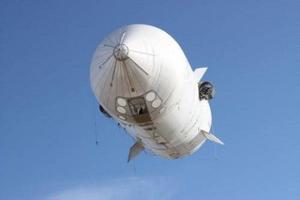BlimpsWorld's largest airship inflated Wednesday for the first time
The world’s largest airship — 235 feet long and 65 feet in diameter — was inflated on Wednesday for the first time; the test took place inside the Garrett Coliseum in Montgomery, Alabama which, the proprietors state, can hold as many as 1,500 cattle (“with milking parlor”); the airship features many innovations, including propelling ducted fans which are mounted along the centerline of the hull rather than beneath it, so that the nose does not lift when more power is applied

E-Green's Bullet demonstration // Source: gas2.org
The “world’s largest airship,” according to its makers, was inflated for the first time on Wednesday and is undergoing ground tests inside a roofed exhibition hall in Alabama which in normal times offers “the space for 1500 cattle.”
The Bullet 580 ship measures 235 feet long and 65 feet in diameter. It is intended to carry payloads of almost one ton to altitudes of 20,000 feet on surveying or surveillance missions.
Lewis Page writes that the Bullet design was developed in Canada by a company called 21st Century Airships, spawned by ballooning and airship enthusiast Hokan Colting (in the 1970s, Colting was a partner in the balloon biz of fellow Swede Per Lindstrand, a noted aerial daredevil). Colting achieved a 20,000-foot-plus airship height record in a spherical 21stCentury airship above Alberta in 2003.
The Bullet design, based on a 21st Century flying prototype called Voyager, offers various special features compared to a standard helium-filled blimp.
Its propelling ducted fans are mounted along the centerline of the hull rather than beneath it, so that the nose does not lift when more power is applied. Slats also allow the pilot to control the airflow emitted by the ducted fans, meaning that traditional tail planes and rudders are not required — and that the ship can still be controlled even when not moving forward through the air. Page notes that this is supposed to offer good maneuverability even when hovering, and to mean that the large ground handling crews required by normal airships are unnecessary.
1930s flying-aircraft-carrier trick revisited?
After twenty-one years in operation during which it flew some fourteen14 airships, 21st Century was bought last year by Kellyton, Alabama-based firm E-Green Technologies, which had previously been involved in trying to market 21st Century airships to U.S. government customers. E-Green says that the new Bullet 580 is being built to carry a joint NASA and academic survey payload intended to measure soil moisture.
<>E-Green adds that the Bullet will be equipped with a “Water Condensate Recovery System [which] reduces need for helium replenishment”, a key requirement for airships not filled with hydrogen or hot air. Helium is expensive: but in general a ship gets lighter as it burns fuel and thus gas will probably have to be vented off to make a landing. Replacing the lost helium for another flight is costly and troublesome.
This snag can be mitigated by the use of vertical thrust, dynamic lift generated in forward flight and ground effects hover/suck ducts (as seen on the Lockheed P-791 demonstrator in recent years). A more conventional vessel like the Bullet would need an answer to the static lift problem. Page writes that most airship designers claim some trick up their sleeve in this area, usually treated as a deep secret: Colting would never divulge what approach 21st Century was taking.
The term “water condensate,” however, probably means the harvesting of steam from the craft’s diesel exhausts to fill water ballast tanks and compensate for burned-up fuel. The U.S. Navy’s flying aircraft carriers of the 1930s used such a system, but it was an acknowledged Achilles heel of theirs. Alternative approaches include the use of neutral-buoyancy gaseous fuel (like the Graf Zeppelin in the 1930s and the TAO sperm-ship nowadays) or the mysterious Control of Static Heaviness gas-squash kit touted by Russo-Californian engineer Igor Pasternak.
With its NASA contract, it seems that E-Green has managed to get together enough cash to build a full-size version of Colting’s design. The test inflation is being carried out inside the Garrett Coliseum in Montgomery, Alabama — “one of the few facilities large enough to host the operation.” The Coliseum is more normally used for agricultural shows and the like: its proprietors proudly state that it can hold 13,500 people, more than 600 horses, as many as 1,500 cattle (“with milking parlor”) and unspecified numbers of swine. “The first flight of the Bullet 580 is planned for later this year,” according to E-Green.
